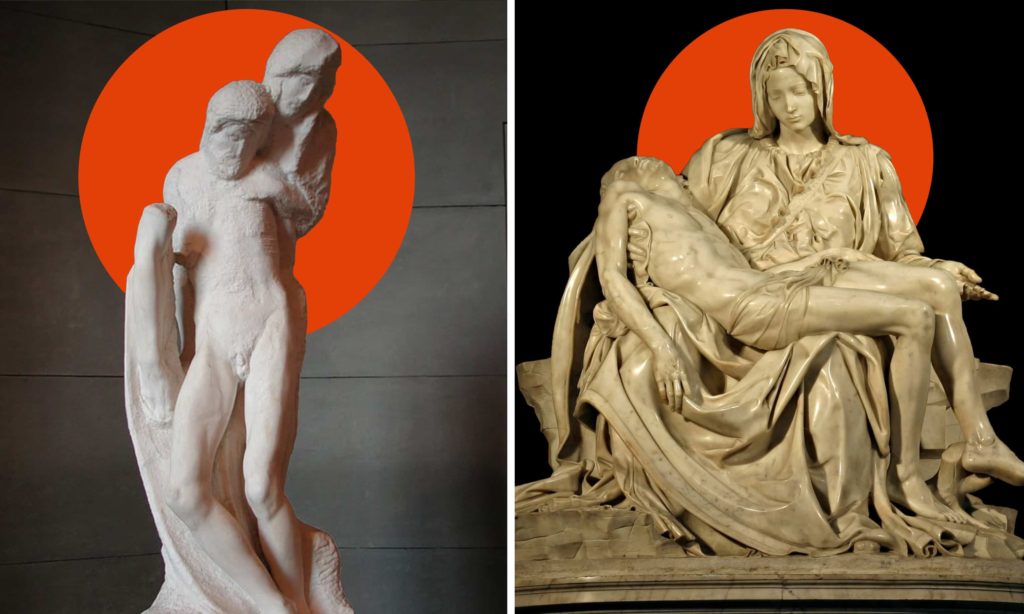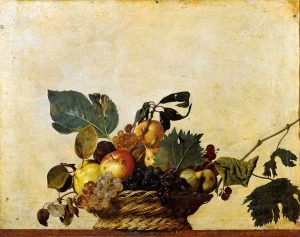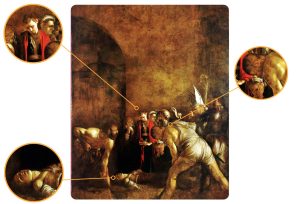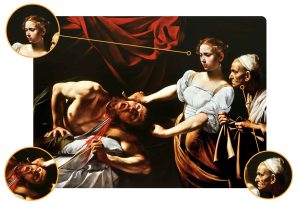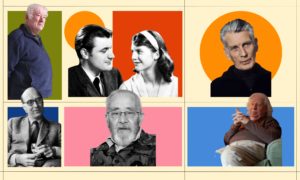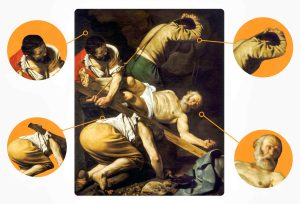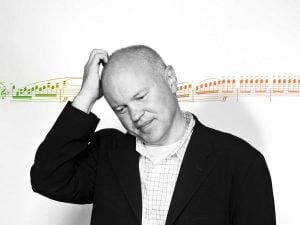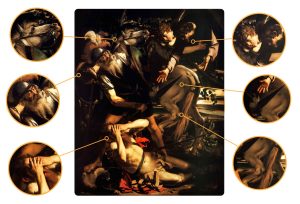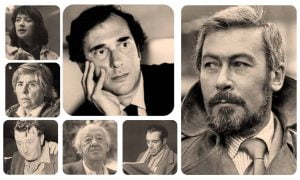The search for perfection, albeit in different ways and forms, has always accompanied man throughout his growth and impacted his socio-historical imprint . Starting from ideas for the improvement and evolution of the most basic aspects of life, such as the perfecting of agricultural or construction techniques, his ambition stretched to the creation of increasingly perfect buildings and works of art. Although there is no universal concept of absolute perfection, because every judgment or perception of beauty is inevitably conditioned by its own yardstick, I find that everyone in art, in any form of art, can find or express their own idea of perfection.
Confronting opposing Pietas
Starting from this duality between conception and perception, I would like to make a rather daring attempt, that is to approach the examination of one of the greatest artists in the history of Italian art: Michelangelo Buonarroti (Caprese 6 March 1475 – Rome February 18 1564).
The evolution of his artistic path is a perfect example of how one can reach formal perfection, and then go beyond it, and perhaps deny it, through the expression of the most intimate perception of perfection and beauty. Recognizing my limitations, I am fully aware that by choosing this topic and applying it to an artist who was, as Vasari also testifies, able to move and express himself in almost all the arts, I am exposing myself to the same risks and ruinous consequences of the flight of Icarus, who fell for daring to fly too close to the sun.
However my personal emotions, linked to the observation, study and comparison between two of Michelangelo’s Pietas (at least three Pietas were certainly made by him) are so strong that they push me to write and share my considerations, accepting all the risks involved.
The Vatican Pieta
Michelangelo lived in a highly stimulating and dynamic historical moment for Italian artists, a time during which they could really live on art and thanks to art, because financed by gentlemen who, in addition to loving to surround themselves with beauty, acquired prestige both from the exhibition of the works of art financed by them and from the signature of the material performer of the work itself. Although these patrons were very often cumbersome and limiting with regards to the free expression of the artist, just as often they proved to be decisive for the creation and birth of authentic masterpieces.
Even the first Pieta that I will examine, namely the Vatican one, was born thanks to the request of a client: Cardinal Jean de Bilhères de Lagraulas, who commissioned Michelangelo to create a sculpture depicting “A dressed Virgin Mary, with a dead Christ in her arms, as big as a righteous man is “.
We know that the artist began the sculpture in 1497 and completed it in 1499, after having personally chosen the block of white marble from Carrara, to be worked with the art of “removing”. It is important, if not fundamental, to pay particular attention to the dates, considering the year of the artist’s birth and the date of the realization of this work (known to us thanks to the contract stipulated between the cardinal and the artist) that Michelangelo executed the Pieta when he was just in his early twenties. He therefore did not get the job because he was already known to most people, rather he accepted it precisely in order to make himself known.

The artist managed to have the cardinal’s trust thanks to the banker Jacopo Galli, for whom he had created a marble sculpture of Bacchus, whose characteristic perfection prompted the banker to introduce Michelangelo to Rome. There, he was contractually commissioned to create the Pieta sculpture which was to be placed in the chapel of Santa Petronilla, probably to be used as a sepulchral monument for the cardinal.
Michelangelo sculpted this work knowing full well that it would be for him much more than a simple funeral monument, but an opportunity to make himself known both in Rome and in other Italian courts. He therefore made the most of his technical knowledge acquired in the years of Florentine training, first at the Ghirlandaio workshop and then perfected at the Giardino di San Marco.
It is in this Medici garden that young emerging and deserving artists were hosted, by the will of Lorenzo the Magnificent, in a stimulating environment, suitable for the study of the artistic techniques of the past. Thanks to the direct observation of the collection of ancient art belonging to the Medici family, young people could acquire the means and skills to reproduce the perfect characteristics of the works of the classical period. In this garden / gym of talents, not only did Michelangelo’s technical training take place, but also a more intimate and philosophical one that saw him approaching Neoplatonic ideals.
The predominance of beauty
These opportunities not only led him to conceive the idea of a truth hidden behind an excess of matter, but also nurtured a search for the sensitive beauty, which he considered a transposition, reflection and testimony of divine beauty transmitted and made visible to man also through art. This concept of beauty clearly shines through in this Vatican Pieta.
The clothed Virgin, just as required by the contract, has a physical structure whose measures give harmony and support the balance of the entire work. Her features do not appear distorted and are barely scathed by her grief for the loss of her son. Even the body of Jesus, helpless and devoid of the dynamic force of living bodies, retains an intact beauty, not diformed by the manner of his death.
Every single muscle of Christ, even if devoid of the spark of life, still seems to retain the memory of that force which until a few hours before was still active and manifest. Typical of a pieta, the Virgin holds her son in her arms and supports him, in a characteristically maternal gesture. Mary’s hands seem to speak to us, giving voice to a hidden and unexpressed thought.
The right hand appears as the hand of the mother who holds and supports her beloved son by drawing him to her as if to keep him close, while the left hand seems to offer the sacrifice of her son, despite her suffering, knowing full well that now more than ever, he is no longer hers alone. In so doing, her status as mother of the Church is highlighted.
The features of the Virgin and the child share the same perfect beauty that makes them seem peers and not mother and son. This detail is not an oversight, or a forcing of Neoplatonic thought, but rather a different way of reading the theme of the pieta, which is not only the representation of a mother holding up her dead child, but that of a mother who already from the moment of the annunciation and the birth of the child knew what fate was reserved for them.
Once the sculpture was finished, the Pietà was positioned as planned inside the chapel of Santa Petronilla, only around 1517 was it transferred to St. Peter’s Basilica in the Vatican. The marble group immediately achieved enormous success. The evident beauty and stylistic perfection of the work, however, left many observers doubting its provenance, leading them to imagine that it was the creation of a mature hand. It is said that Michelangelo, listening to two men praising his statue, but attributing it to another sculptor, decided to put his signature on the band that holds the Virgin’s shoulder strap, indicating not only his identity, but also his city of origin and training : Florence.
Before examining the other Pieta and to highlight the perfect beauty of the Vatican statue, I quote Vasari’s comment on this first Pieta by Michelangelo, fifty years after its realization:
"Do not ever think, oh sculptor or rare craftsman, to be able to add design, grace, or effort, nor to be able to refine, purify or pierce the marble, as deftly as Michelagnolo did in with his art, because one can see in it all the value and power of art is".
The Rondanini Pieta
In examining the other Pieta, the Rondanini one (so called because it was purchased by the Rondanini family in 1744), I will start again from the dates of its creation that place it between 1552 and 1564. It is said that Michelangelo worked on it, without ever finishing it, until a few days before his death, in a period of his life in which the artist no longer sculpted under commission, but exclusively for personal impulse.

Probably the master worked on it while contemplating the decoration for his own burial monument. If we consider the dates of realization of the two Pietas, limiting ourselves to observing what we see without any introspective examination, we would certainly be misled because in most artistic studies, the critical examination of the works leads one to divide the different creative phases of the artists into a timeline that almost always coincides with a line of evolution and improvement of technique.
Following this methodology of study and approach, thus leaving out the most intimate and conceptual considerations, we should imagine the two Pietas with inverted dates. Therefore, the Rondanini Pieta would come first and the Vatican one, last. The stylistic differences with respect to the Vatican Pieta are enormous both in the “structural” setting of the work and in the type of technical workmanship.
The composition of the characters in the Rondanini Pieta is opposite to that of the first, because it has a vertical development where Jesus and Mary are reproduced in a pose that does not allow for the meticulous attentions of Vatican sculpture. In the Vatican Pieta, not only the two bodies, but also the folds of Maria’s dress had been designed and studied to create a perfect balance in the overall look of the work.
The idea of a vertical development of a pieta was a great novelty in the artistic field. This originality and desire to dare and experiment, is also usually made to coincide with the artistic approach of the young artist who needs to be noticed and known. In our case, Michelangelo had already known the fame and glory. He had achieved them thanks to his respect for all the technical and philosophical rules acquired in the years of his youth.
At the time of the realization of the Rondanini Pieta, the artist, now elderly, felt free from the needs of personal affirmation of the early days of his career, moreover, having no client constraints, he could express himself in a freedom that I would define as an expression of thought and form, aware of being able to make visible one’s own concept of a pieta.
The predominance of truth
The Virgin in the Rondanini sculpture is standing and not sitting as in Vatican Pieta, she embraces and supports the dead son whose legs, bent towards the left of the observer, are the only true support and balancing point of the entire work. The faces, although not perfectly defined and finished, express a feeling of pain and profound resignation.
Every single stroke of the chisel gives the idea of the unfinished, nothing has been smoothed and worked in the manner of Vatican Pieta, but I believe this has nothing to do with the unfinished nature of the work. Every crack, every lack of completeness, is certainly the result of the precise will of Michelangelo, who in this embrace, so different from the first he made, transmitted his thoughts on pain and death.
Not only the death of Jesus, which Michelangelo as a believer knew how to express, but also of his own death that he now felt ever closer. This awareness and much of the conceptuality behind the work, I find can be read and deciphered thanks to the aforementioned vertical development of the structure, which with a height of 195 cm allows for different interpretations. Observing the piety from top to bottom, it is possible to see a mother holding her dead son in a last strong embrace before laying him on the ground.
Looking instead at the work from a different perspective, from bottom to top, we see Mary supporting her son in anticipation of the imminent resurrection. Both interpretations appear entirely plausible, but perhaps the most profound and true reading is the one that is offered through frontal observation, which presents the body of Mary and her son merged in a last embrace equal to the first, that is, as that of the moment of the conception of Jesus. Mary then almost seems ready to welcome her son back into her body.
I do not know if all these considerations are correct, for this reason I do not know if it is right to share them, but I believe that art is nothing more than a means, a vehicle, to give voice to emotions, not only those of the artist, but also those of the observer.
For me it was a revelation to feel, through the examination and comparison of these two works, that artistic maturity does not always coincide with the perfection of style and expression, but rather with the achievement of the awareness of will and power express what is believed to be one’s own perfect thought, achieved by scratching and crumbling one’s knowledge, one’s certainties, to reduce them to a minimum in order to find the truth, or at least one’s own truth.
The perfect beauty of the first Pieta could no longer correspond to the dawning personal anticipation of Michelangelo’s own death, who by now was old and who no longer had the urge to capture beauty as much as truth. It is in the truth that pain, or even only the idea of pain and death, appears for what it is and above all makes us appear for what we are, revealing our essence without any conceptual superstructure.



